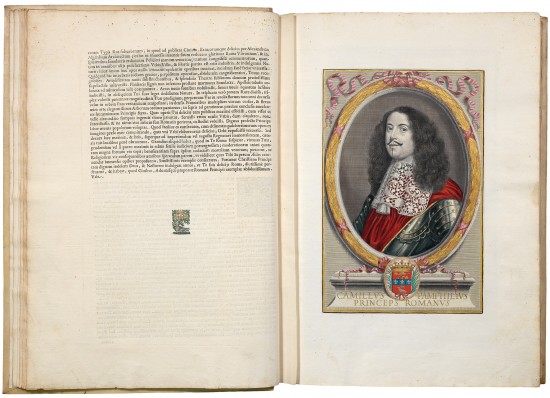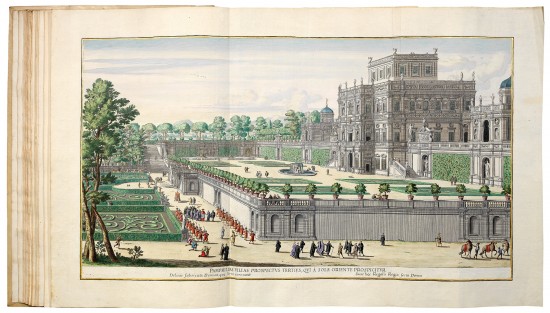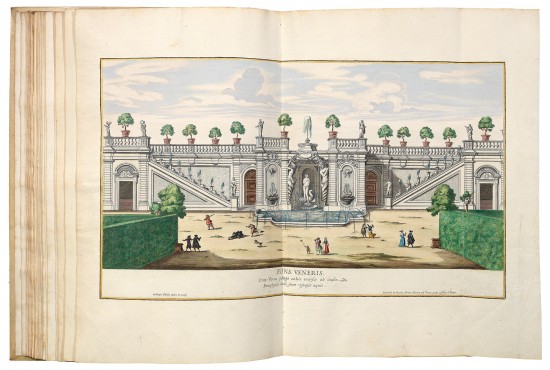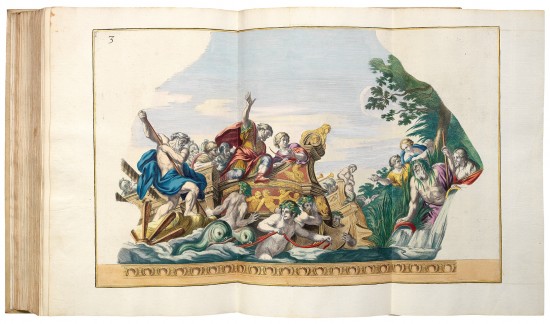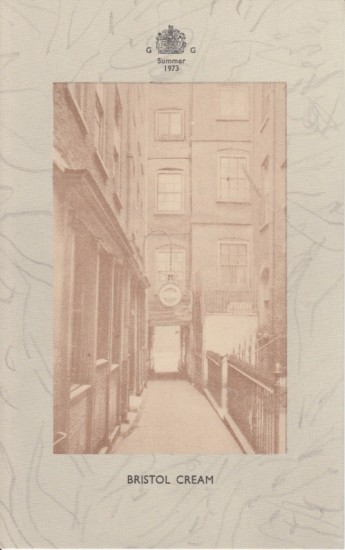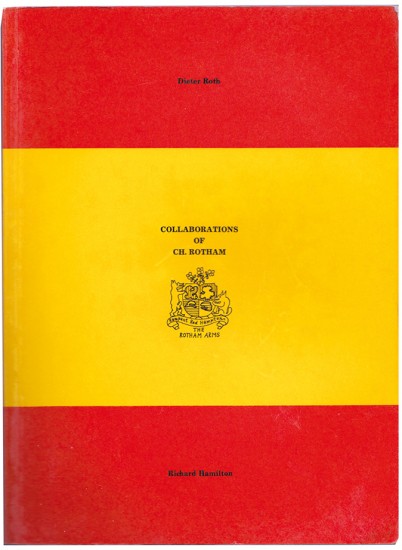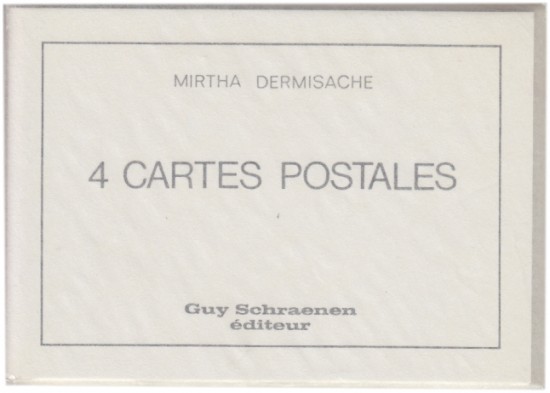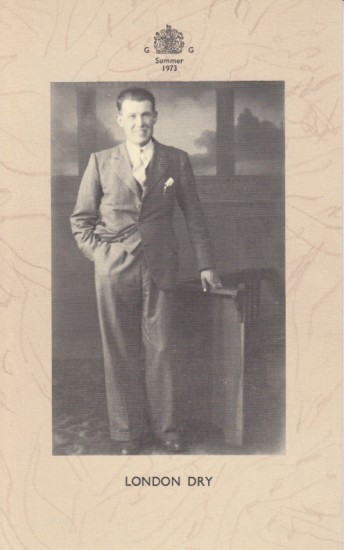Villa Pamphilia eiusque Palatium, cum suis Prospectibus, Statue, Fontes, Vivaria, Theatre, Areolae, Plantarum, Viarumque ordines, cum eiusdem Villae absoluta delineatione [Together with:] Galeria Dipinta nel Palazzo del Prencipe Panfilio da Pietro Berrettini da Cortona
Barriere, Dominique, Giovanni Battista Falda & Carlo Cesio
Rome. Giovanni Giacomo de' Rossi. c.1675; c.1690
Sold
A superb union of two rare works - almost certainly for presentation - on the Villa Pamphilia with the plates very finely coloured by a contemporary hand and heightened with gum arabic and gold and silver.
The Villa Pamphilia (today the Villa Doria Pamphili) is, without doubt, the most imposing of the great Roman villas constructed during the course of the 16th and 17th centuries. In 1630, Panfilo Pamphili (1564 - 1639) acquired the land and building (the Villa Vecchia) on the periphery of Rome for a garden villa; that same year the Pamphilia family had begun construction on the Palazzo Pamphilia in the piazza Navona. The elevation of Panfilo's brother, the cardinal Giovanni Battista Pamphili, to the papacy in 1644 as Innocent X, required a more imposing villa and grander palazzo to reflect the new status of the family. Camillo Pamphili (1622 - 1666), the son of Panfilo and Olimpia Maidalchni, was named cardinal by his uncle shortly after his enthronement, an office he renounced in 1647 to marry Olimpia Aldobrandini.
Camillo Pamphili, collector, patron of the arts and connoisseur, supervised the construction of the Villa Pamphilia which had been entrusted to the architect Francesco Grimaldi and, for the gardens, to the sculptor Alessandro Aguardi with the assistance of the botanist Tobia Aldini. The construction of the villa, begun in 1645 was completed in 1647, but the ornamentation of the facade and the arrangement of the gardens took a further six years. The gardens were decorated with the Pamphilo family collection of sculpture, with ancient and modern works displayed in niches or free-standing. Camillo was also responsible for the large fresco for the long gallery - commissioned from Pietro da Cortona - depicting the life of Aeneas, the Trojan exile and progenitor of the Roman people, from whom the Pamphilis claimed descent.
Yet, in 1650, Camillo Pamphili was no longer either the official owner of the villa, nor the palazzo, and due to his abandonment of the Cardinal's beretta in order to marry Olimpia Aldobrandini, he and his new wife had been exiled from Rome on the order of his uncle the Pope. Innocent nominated Camillo Astalli cardinal in place of his nephew and adopted him in the same year, giving him the name Pamphili: one Camillo Pamphili replaced another Camillo Pamphili in the affections of the Pope and in the Vatican hierarchy. The Papal Bull issued to legitimate Innocent's reconfiguration of his patronage went further and gave both the newly constructed Villa Pamphilia and the Palazzo Pamphilia to the new Camillo Pamphili. Despite the technicalities of Camillo (Astalli) Pamphili's ownership of both palazzo and villa, it appears that the disgraced Camillo Pamphili remained in superintendence of the building works at the villa; Camillo was reconciled with his uncle in 1651 and his replacement was stripped of his new name and his titles in 1654.
Camillo Pamphili commissioned Dominique Barrière, French-born and one of the most accomplished and important architectural artists then residing in Rome, to make a series of drawings and engravings of the Villa Pamphili. Camillo never saw the fruits of his commission - he died in 1666 - and it is probable that it was his son Giambattista who was the first to see Barrière's productions and who published the present work.
'These plates, peopled by small figures (one shows the procession of the Pope through the grounds, accompanied by his guards and entourage), are unsigned but close in style to that of Falda whose signature is on the double-page plan of the grounds and the four plates of fountains.' (Weinreb).
This exceptional copy, combining these two important works, the first on the Villa and the second on the Aeneic frescos by Pietro da Cortona, with the very fine colouring by a contemporary hand and additional heightening with liquid gold and silver and gum arabic, is very likely a presentation copy, produced for Giambattista Pamphilo in memory of his father Camillo and as a memorial of the illustrious Pamphilo family. The exceptional quality of the colouring and the exquisite additional heightening with gold and silver, all by a contemporary hand, marks this copy as oustanding; we can trace no other copies with colouring by hand of either work, at auction or in collections.
The book features the ownership signature 'Shelburne' to the front free endpaper and it seems plausible that it was purchased by William Petty, the second Earl of Shelburne (1737 - 1805) during his Grand Tour in 1771. A Whig politician (significant for establishing the terms under which the Treaty of Paris ending the American Revolutionary War was negotiated), Petty was also a renowned collector of antiquities and works of art who commissioned Gavin Hamilton to purchase a number of works of classical statuary, landscape painting and depictions of the Trojan War. Shelburne, created Marquess of Lansdowne in 1787, had also collected an exceptional corpus of manuscripts including highly significant Elizabethan documents (such as the correspondence of Lord Burghley) which were sold after his death, in 1807, over several days at auction. The book also features the armorial bookplate of Emily Mercer Lansdowne to the front pastedown. Emily Jane Mercer Elphinstone Petty-Fitzmaurice (1819 - 1895), née Emily Jane de Flahaut in Edinburgh, was the daughter of the exiled Comte de Flahaut (1785 - 1870) and his wife, Baroness Keith. The Comte de Flahaut, lover of Hortense de Beauharnais (with whom he had a son, the Comte de Mornay), was very likely the illegitimate son of the French statesman Talleyrand and was after 1800, an active supporter of Napoleon. After Waterloo and the failed attempt to put Napoleon II on the French throne, de Flahaut - with Talleyrand's influence - went into voluntary exile in Germany and then Scotland. It was in Edinburgh that his daughter Emily became engaged to Henry Petty-FitzMaurice who succeeded to the Marquessate in 1863 as the fourth Marquess.
[First work: Berlin 3491 (82 plates); Brunet V, 1233 (87 plates); Cicognara 3911; Weinreb 23:70, 37:8; Second work: Berlin 4095; Brunet 811 - 812; see Shelburne's entry in 'A Dictionary of British and Irish Travellers in Italy 1701 - 1800', London, 1997].
The Villa Pamphilia (today the Villa Doria Pamphili) is, without doubt, the most imposing of the great Roman villas constructed during the course of the 16th and 17th centuries. In 1630, Panfilo Pamphili (1564 - 1639) acquired the land and building (the Villa Vecchia) on the periphery of Rome for a garden villa; that same year the Pamphilia family had begun construction on the Palazzo Pamphilia in the piazza Navona. The elevation of Panfilo's brother, the cardinal Giovanni Battista Pamphili, to the papacy in 1644 as Innocent X, required a more imposing villa and grander palazzo to reflect the new status of the family. Camillo Pamphili (1622 - 1666), the son of Panfilo and Olimpia Maidalchni, was named cardinal by his uncle shortly after his enthronement, an office he renounced in 1647 to marry Olimpia Aldobrandini.
Camillo Pamphili, collector, patron of the arts and connoisseur, supervised the construction of the Villa Pamphilia which had been entrusted to the architect Francesco Grimaldi and, for the gardens, to the sculptor Alessandro Aguardi with the assistance of the botanist Tobia Aldini. The construction of the villa, begun in 1645 was completed in 1647, but the ornamentation of the facade and the arrangement of the gardens took a further six years. The gardens were decorated with the Pamphilo family collection of sculpture, with ancient and modern works displayed in niches or free-standing. Camillo was also responsible for the large fresco for the long gallery - commissioned from Pietro da Cortona - depicting the life of Aeneas, the Trojan exile and progenitor of the Roman people, from whom the Pamphilis claimed descent.
Yet, in 1650, Camillo Pamphili was no longer either the official owner of the villa, nor the palazzo, and due to his abandonment of the Cardinal's beretta in order to marry Olimpia Aldobrandini, he and his new wife had been exiled from Rome on the order of his uncle the Pope. Innocent nominated Camillo Astalli cardinal in place of his nephew and adopted him in the same year, giving him the name Pamphili: one Camillo Pamphili replaced another Camillo Pamphili in the affections of the Pope and in the Vatican hierarchy. The Papal Bull issued to legitimate Innocent's reconfiguration of his patronage went further and gave both the newly constructed Villa Pamphilia and the Palazzo Pamphilia to the new Camillo Pamphili. Despite the technicalities of Camillo (Astalli) Pamphili's ownership of both palazzo and villa, it appears that the disgraced Camillo Pamphili remained in superintendence of the building works at the villa; Camillo was reconciled with his uncle in 1651 and his replacement was stripped of his new name and his titles in 1654.
Camillo Pamphili commissioned Dominique Barrière, French-born and one of the most accomplished and important architectural artists then residing in Rome, to make a series of drawings and engravings of the Villa Pamphili. Camillo never saw the fruits of his commission - he died in 1666 - and it is probable that it was his son Giambattista who was the first to see Barrière's productions and who published the present work.
'These plates, peopled by small figures (one shows the procession of the Pope through the grounds, accompanied by his guards and entourage), are unsigned but close in style to that of Falda whose signature is on the double-page plan of the grounds and the four plates of fountains.' (Weinreb).
This exceptional copy, combining these two important works, the first on the Villa and the second on the Aeneic frescos by Pietro da Cortona, with the very fine colouring by a contemporary hand and additional heightening with liquid gold and silver and gum arabic, is very likely a presentation copy, produced for Giambattista Pamphilo in memory of his father Camillo and as a memorial of the illustrious Pamphilo family. The exceptional quality of the colouring and the exquisite additional heightening with gold and silver, all by a contemporary hand, marks this copy as oustanding; we can trace no other copies with colouring by hand of either work, at auction or in collections.
The book features the ownership signature 'Shelburne' to the front free endpaper and it seems plausible that it was purchased by William Petty, the second Earl of Shelburne (1737 - 1805) during his Grand Tour in 1771. A Whig politician (significant for establishing the terms under which the Treaty of Paris ending the American Revolutionary War was negotiated), Petty was also a renowned collector of antiquities and works of art who commissioned Gavin Hamilton to purchase a number of works of classical statuary, landscape painting and depictions of the Trojan War. Shelburne, created Marquess of Lansdowne in 1787, had also collected an exceptional corpus of manuscripts including highly significant Elizabethan documents (such as the correspondence of Lord Burghley) which were sold after his death, in 1807, over several days at auction. The book also features the armorial bookplate of Emily Mercer Lansdowne to the front pastedown. Emily Jane Mercer Elphinstone Petty-Fitzmaurice (1819 - 1895), née Emily Jane de Flahaut in Edinburgh, was the daughter of the exiled Comte de Flahaut (1785 - 1870) and his wife, Baroness Keith. The Comte de Flahaut, lover of Hortense de Beauharnais (with whom he had a son, the Comte de Mornay), was very likely the illegitimate son of the French statesman Talleyrand and was after 1800, an active supporter of Napoleon. After Waterloo and the failed attempt to put Napoleon II on the French throne, de Flahaut - with Talleyrand's influence - went into voluntary exile in Germany and then Scotland. It was in Edinburgh that his daughter Emily became engaged to Henry Petty-FitzMaurice who succeeded to the Marquessate in 1863 as the fourth Marquess.
[First work: Berlin 3491 (82 plates); Brunet V, 1233 (87 plates); Cicognara 3911; Weinreb 23:70, 37:8; Second work: Berlin 4095; Brunet 811 - 812; see Shelburne's entry in 'A Dictionary of British and Irish Travellers in Italy 1701 - 1800', London, 1997].
2 works in 1 vol. Folio. (450 x 325 mm). First work with 84 engraved plates, all with additional colouring and heightening with gum arabic by hand, as follows: printed title with engraved Pamphilo arms and imprimatur verso, leaf with dedication to 'Illustirissimo et Excellentissimo / D. Principi D. Ioannis Baptistae / Pamphilio' (the Pope) with large woodcut head-piece, 9-line decorative initial, small woodcut vignette beneath dedicatees name recto and woodcut tail-piece verso, leaf with engraved portrait of Camillo Pamphilo by L. Visscher after Genouen, leaf with engraved gate of the Villa Pamphilo by Barrière, leaf with folding plan of the garden by Falda, five leaves with five large unsigned engraved folding plates of views of the Villa and gardens ('Pamphiliae Villae Prospectus Primus - Quintus'), leaf with folding plate ('Fons Veneris') by Falda, 3 leaves with engraved plates of fountains by Falda, 50 unsigned engraved plates of statuary and 22 unsigned engraved plates of busts; second work with 16 engraved plates numbered 1 - 16 in manuscript in black ink, all with additional colouring and heightening with gum arabic by hand, as follows: double-page plate with title, 5 further double-page plates, 2 single page plates and eight folding plates, final folding plate with dedication by Carlo Cesio to the Pope. Sheet size: 442 x 312 mm (single sheet). Colouring: all engraved plates with additional colouring and heightening with gum arabic by a contemporary hand, single page plates of the statues and busts in the first work with hand-coloured borders in red and yellow, the remaining plates in both works with borders in black and liquid gold, the Pamphilo arms - where depicted in either work - with additional heightening in liquid gold and silver, the printed text for the titles of both works with text illuminated in liquid gold, the initial, head-piece, vignette and tail-piece of the dedication with additional colouring and heightening in liquid gold, the portrait, views of the Villa, fountains and the frescos in the second work all with additional detail heightened in liquid gold. Full contemporary vellum, boards with decoration à la Duseuil to surround large central vignette featuring an astrolabe tool, banded spine, a.e.g.
#43340
